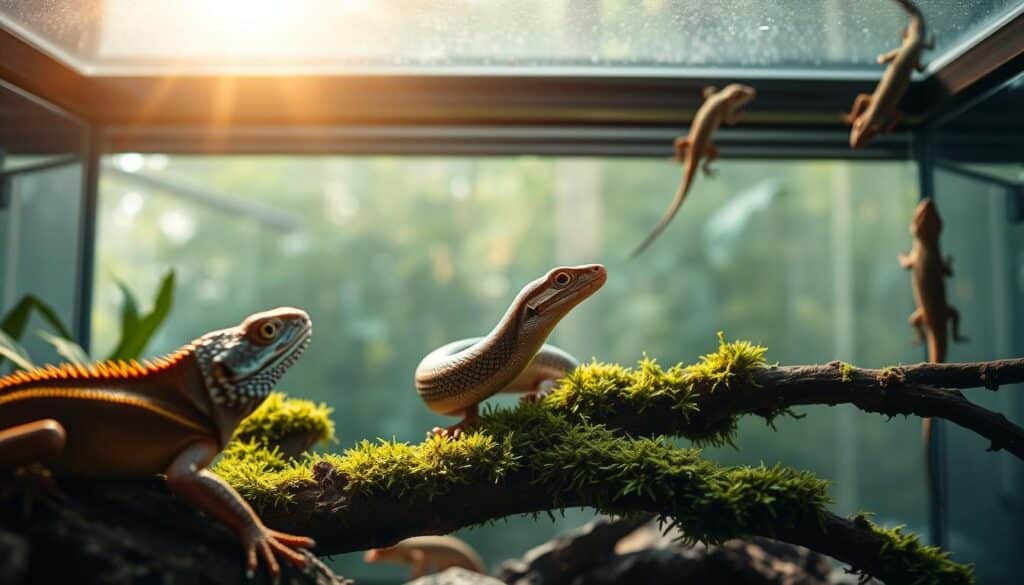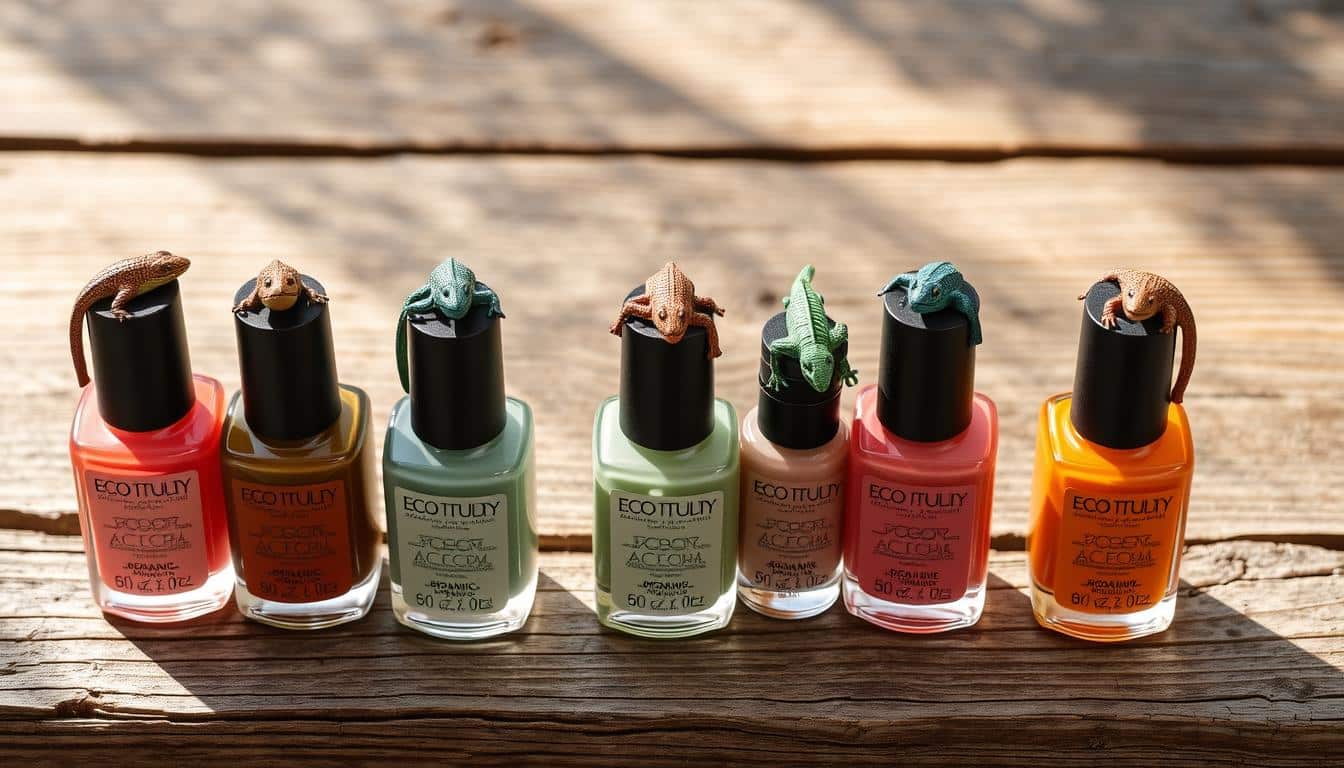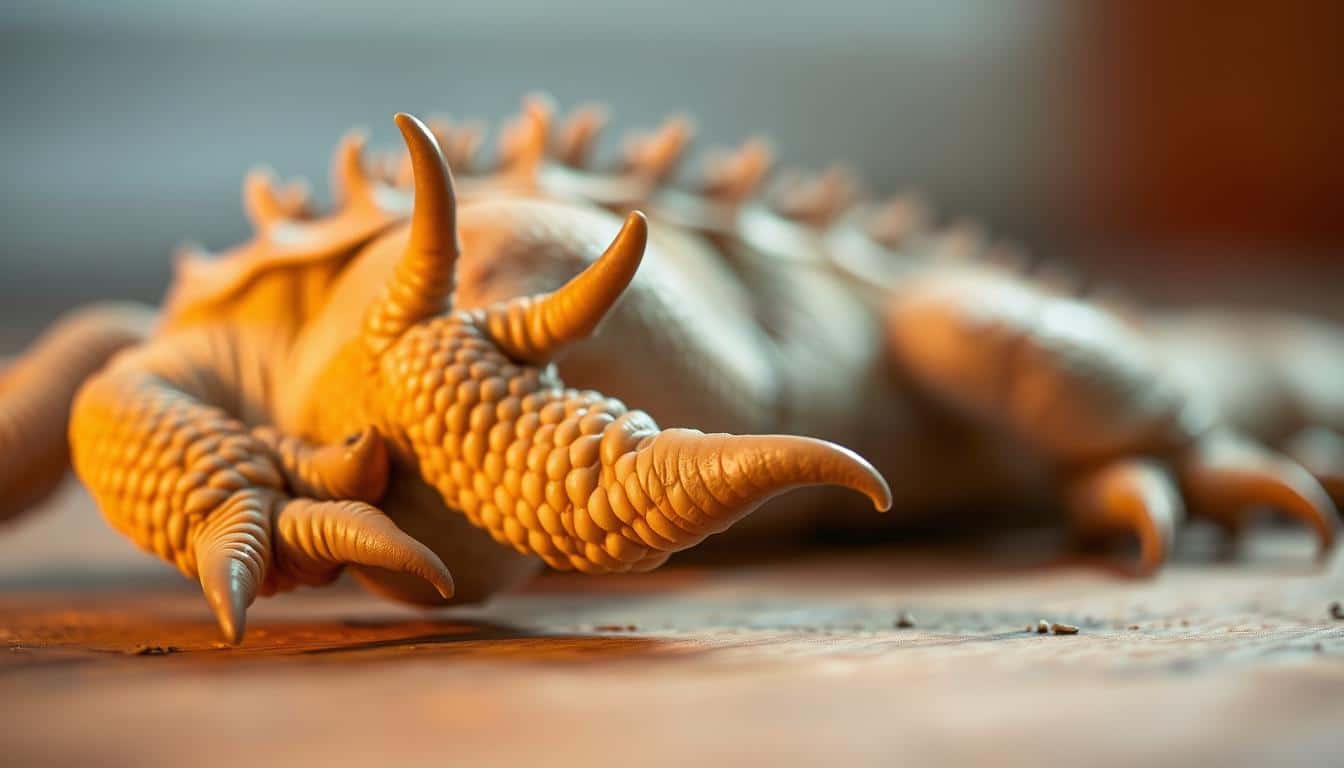Anúncios
For reptile fans, it’s key to keep your pet clean, including their nails. Using safe manicure tips makes your reptile look good and keeps them healthy. Trimming their nails regularly helps prevent injuries to both your pet and you. This ensures everyone can have fun safely. Here, we’ll cover the basics needed to care for your reptile’s nails properly.
Understanding Why Nail Care is Important for Reptiles
Proper nail care is crucial for a reptile’s health and activities. Overgrown nails can cause discomfort and restrict their movement. This can stress them out and make them prone to health problems.
Keeping nails trimmed improves a reptile’s safety and comfort. It prevents nails from catching on stuff, causing pain or infection. It also helps reptiles climb and dig, which is good for their physical and mental health.
By focusing on nail care, owners can create a better life for their reptiles. Good nail grooming is not just about looks. It makes reptiles happier and healthier.
Common Nail Issues in Reptiles
Nail problems can really affect a reptile’s health. If nails get too long, they can’t move well and might feel pain. It’s key to spot these issues early to help them. Another big issue is when nails split. This can happen if there’s not enough humidity or the right nutrients in their food. Brittle nails can easily get hurt.
If their nails aren’t taken care of, infections might start. Good nail care means checking their nails often, keeping their home right, and feeding them well. Owners need to know these signs to keep their reptiles happy and healthy.
Safe Manicure Tips for Reptile Enthusiasts
Start by checking the reptile’s nails to see if they’re healthy and the right length. Doing this often helps you notice if they’re too long or have other problems. Knowing how long the nails should be is very important. If they’re not the right length, it can hurt or injure your pet.
Assessing Nail Length and Health
When looking at your reptile’s nails, you should check for:
- Signs of overgrowth, such as curling or splitting
- Discoloration or any abnormalities
- Regular wear from natural behaviors or surfaces
Keeping an eye on these things is key to your pet’s health and avoiding issues. It’s important to check regularly for a safe and smooth nail trimming session.
Tools Needed for Safe Nail Trimming
For safe nail cutting, you need some special tools. You will need:
- Specialized reptile nail clippers designed to minimize stress
- Nail files for smoothing rough edges
- Styptic powder to stem bleeding in case of accidental cuts
Having the right tools makes the process better, making sure both you and your reptile are comfortable. This way, nail care is safe and stress-free.
Choosing the Right Nail Trimming Tools for Reptiles
Finding the perfect nail trimmers for reptiles is key to an easy grooming session. There are many types of clippers designed for different sizes and needs of reptiles. For the big guys, scissor-type clippers are great because they give you more control.
Small reptiles do better with guillotine-style clippers, which ensure a clean cut without too much pressure.
After you trim their nails, using an emery board or nail grinder smooths out any rough spots. This stops their nails from catching on things and gives a neat look. Choosing the right nail clippers makes trimming easier, safer for your reptile, and less stressful for both of you.
Step-by-Step Guide to Safe Nail Trimming
Trimming your reptile’s nails is crucial for its health and happiness. Knowing the right way to hold your reptile during nail care makes things smoother for both of you. This guide shows how to trim your reptile’s nails safely using the best techniques.
Positioning Your Reptile for Comfort
When getting ready to trim nails, making sure your reptile feels comfortable is important. Setting up your reptile correctly can lessen stress for both your pet and you. Here are some tips for getting your reptile in the right position:
- Gently handle your reptile to create a calm environment.
- Use a secure cloth to wrap the reptile comfortably without causing stress.
- Support the reptile’s body firmly, allowing its limbs to be easily accessible.
Trimming Techniques to Avoid Injury
Choosing the correct nail trimming method is key to a safe nail trimming session. Keep these steps in mind for a safe trim:
- Identify the transparent tips of the nails to avoid cutting into the quick.
- Trim only the visible part of the nail, keeping a safe distance from sensitive areas.
- Use sharp, specialized reptile nail clippers to achieve a clean cut.
Signs Your Reptile May Need a Nail Trim
It’s important to know when your reptile’s nails are too long. Watching your pet will help you see signs that they need a trim. Look for these clues:
- Visibly long nails that curl or snag on surfaces.
- Bleeds or tears resulting from overgrown nails.
- Changes in behavior, such as reluctance to climb or move around.
Knowing these signs helps reptile owners take good care of their pets’ nails. Check their nails often. This will keep them comfortable and prevent injuries. It’s key for a healthy reptile home.
Post-Trimming Care for Reptile Nails
Aftercare for reptile nail trimming is very important for a good recovery. Right after trimming, check the nails for bleeding or damage. Use styptic powder or flour on any bleed to help stop it quickly. Keeping your reptile in a warm, calm place helps it get comfortable after the trim.
Doing things to care for your reptile’s nails after trimming keeps them healthy. Check the nails often to catch any issues early. Make sure their home has the right moisture. Too dry, and their nails could get brittle and break easier.
Alternative Options to Traditional Nail Trimming
If you love reptiles and want to skip nail trimming, there are natural ways to keep their nails healthy. Making their living space similar to their wild homes is key to natural nail care for reptiles. Adding rough areas lets their nails stay in shape naturally.
Here are some methods to stop reptile nails from getting too long:
- Provide textured climbing structures that stimulate natural behaviors.
- Utilize specific substrates designed to assist in nail wear.
- Ensure regular activity opportunities to keep reptiles engaged and promote self-maintenance.
These nail trimming alternatives lead to a better life for your reptiles. By improving their living spaces, you help them stay healthy and take care of their nails.
Understanding Your Reptile’s Natural Behaviors
It’s key to know how your reptile behaves naturally. This helps us create a good home for them. Such behaviors affect their care needs, like how we manage their nails. A good home includes things that mimic where they’d live in the wild.
This setup lets them do activities good for their health. Things like having the right spots to grind their nails are important.
Providing Natural Grinding Surfaces
For healthy reptile nails, it’s smart to use natural grinding surfaces. You should put different materials in their space, such as:
- Lava rocks
- Rough surfaces of untreated wood
- Coarse gravel
These items help reptiles keep their nails short on their own as they move around. Watching how reptiles use these helps us understand what they naturally do. Knowing their behaviors means we can make their homes better. And it helps prevent the need for us to cut their nails often, keeping them healthy.

Conclusion
Nail care is super important for reptile owners. Keeping your pet’s nails healthy affects their overall happiness. By looking after their nails, you can avoid common problems caused by ignoring them. This helps your reptiles stay happy and comfy.
For safe reptile manicures, you need the right approach. This includes picking proper tools and knowing how your reptile acts. It’s important to trim their nails regularly. Doing so keeps their living space clean, helping them live their best life with you.
Learning about nail health is key if you have reptiles. The tips in this article will help you keep them pain-free. Learning these will make you a better, more knowledgeable reptile owner.



